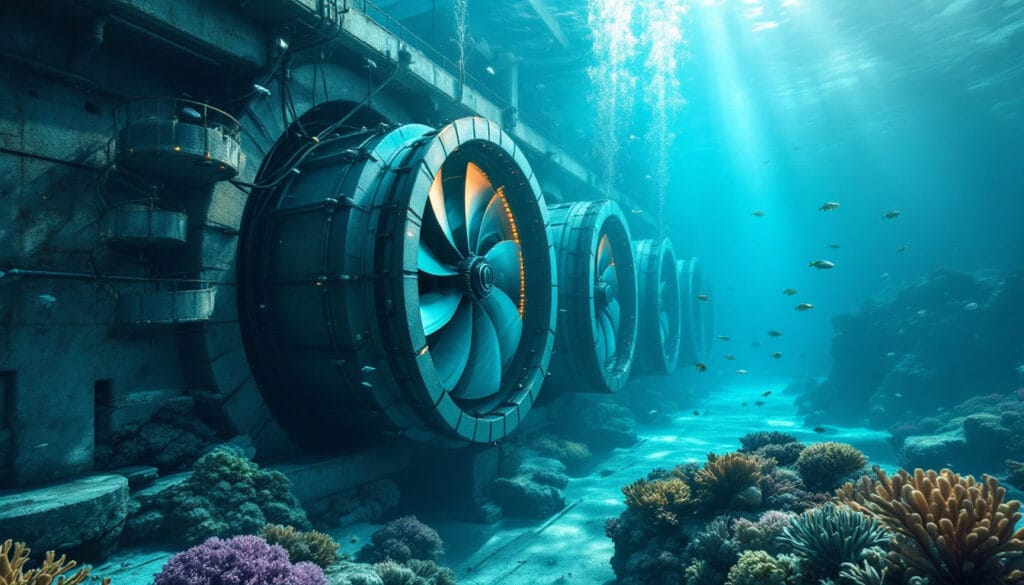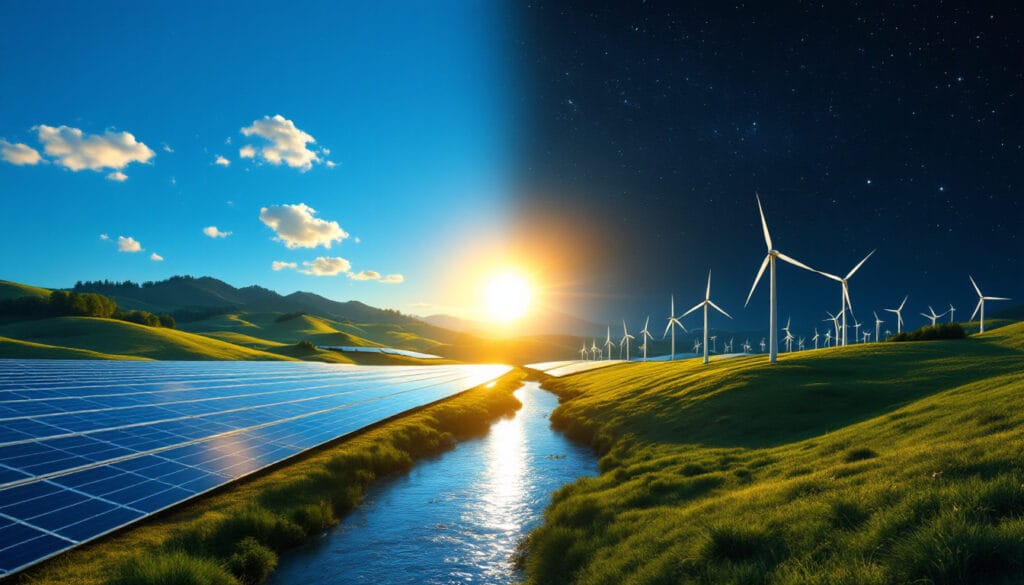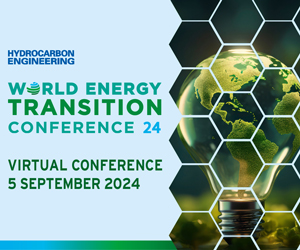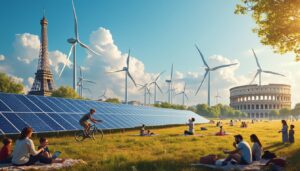Hydro turbines convert the force of ocean or river currents into electricity, using the same principle as wind turbines. Thanks to the density of water, which is a thousand times greater than that of air, a hydro turbine efficiently converts the kinetic energy of water into mechanical energy, which is then transformed into electricity by a generator. They are increasingly used to harness the power of natural currents and represent a promising solution in the field of renewable energy. Projects are multiplying, such as that between Paimpol and the island of Bréhat, strengthening the role of hydro turbines in the global energy transition.
Hydro turbines are innovative devices that transform the kinetic energy of ocean currents into electrical energy. Like wind turbines, they use the movement of water rather than that of air to turn blades attached to a turbine. This process allows for an efficient conversion of the kinetic energy of currents into mechanical energy, which then powers a generator to produce electricity.
The fundamental principle of a hydro turbine operates similarly to that of a wind turbine but is adapted to the aquatic environment. Water, with a density nearly 1,000 times greater than air, generates considerable power even at equivalent speeds. This means that a hydro turbine can produce a large amount of energy with a gentler water flow compared to a wind turbine, which requires strong winds.
The installation of hydro turbines can be done in various ways: placed on the seabed or fixed beneath the water’s surface. When a turbine is set in motion by the flow of water, it drives an alternator that produces a direct electrical current. This current is then converted into alternating current to be usable by electrical grids.
In terms of energy potential, France holds a favorable position with an estimated capacity between 3 and 5 gigawatts, just behind the United Kingdom. Two particularly promising sites include the Raz Blanchard and the Fromveur Passage, where natural currents can be optimally harnessed. The first hydro turbine in France was established off the coast of Paimpol, marking a significant step towards exploiting this source of renewable energy.
Hydro turbines are not only suited for marine environments; they can also be installed in rivers. An excellent example is found in the Garonne, where a river hydro turbine was tested to produce electricity using a current of 2 meters per second, reaching a maximum power of 20 kW. This demonstrates the versatility of this technology and its potential to meet varied energy needs.
Despite their many advantages, hydro turbines face certain challenges. Their impacts on aquatic wildlife and flora must be carefully evaluated to ensure harmonious integration into ecosystems. Furthermore, the high initial cost associated with the installation and maintenance of these infrastructures represents an obstacle to overcome for large-scale adoption. Nevertheless, with consistent advancements in materials and design, the efficiency and durability of these technologies continue to improve, promising a bright future for hydroelectric energy.
To learn more about the potentials of marine energy, visit these resources: Marine energy: a potential to discover, Understanding renewable marine energy.

“`html
Frequently Asked Questions
Q : How does a hydro turbine work?
A : Hydro turbines function by utilizing the flow of water, such as ocean or river currents, to turn blades. This converts the kinetic energy of water into mechanical energy, which is then transformed into electrical energy by a generator.
Q : What are the benefits of hydroelectric energy?
A : Hydroelectric energy is a renewable energy source that does not produce greenhouse gases. It uses water, a natural and inexhaustible resource, and takes advantage of the constancy and predictability of ocean and river currents.
Q : What is the energy potential of hydro turbines in France?
A : France has an estimated potential of 3 to 5 gigawatts (GW), with promising sites such as Raz Blanchard and the Fromveur Passage. This makes it the second largest hydroelectric energy site in Europe after the United Kingdom.
Q : Where was the first hydro turbine installed in France?
A : The first hydro turbine in France was installed in Brittany, between Paimpol and the island of Bréhat, in August 2011, at a depth of 35 meters.
Q : What challenges must still be addressed for hydroelectric energy?
A : Despite its advantages, hydroelectric energy must overcome challenges such as its environmental impact on aquatic wildlife and flora, the high initial cost of development and installation, as well as the ongoing need for research to improve its performance and sustainability.
Articles similaires
Thank you!
We will contact you soon.













